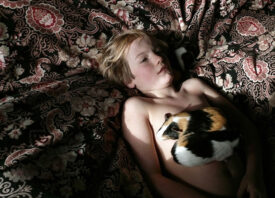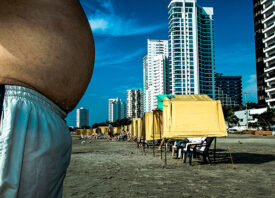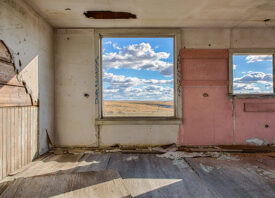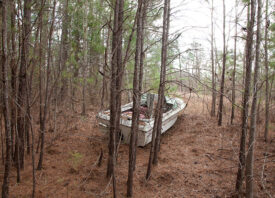Search this site
Along the Railroad Tracks, a Forgotten Landscape



John Sanderson grew up in New York City, but he still remembers the trips his family took to the American countryside–and one day, in particular. “It was a late afternoon with my father during one of our trips to Pennsylvania,” he tells me. “We were walking over tracks and earth blackened from years of coal and oil deposits in the old industrial city of Scranton. The crisp winter air of late April swept across the landscape, carrying with it the delicious smell of creosote, that sweet-smelling tar they put on to preserve railroad ties.” Even then, he knew there were stories waiting to be discovered along the country’s winding railroad tracks.
As an adult and a photographer, Sanderson would return to the railroad, this time carrying a large-format 8×10 camera. Though he was initially drawn to the trains themselves, he found himself increasingly interested in the environments that surrounded the tracks. “I stepped back and photographed the railroad independent of the train,” he remembers. “One image grew into the next. Soon enough, the tracks began underscoring each image, and the project Railroad Landscapes was born.”
Sanderson traverses the country by car, following the path marked by the tracks. Each trip might stretch from around two weeks to a month, with the artist chasing light from one state to the next. “I camped out of my car quite a bit,” he explains. “This allowed me to wake up early at the locations I wanted to photograph. When I’m traveling with the camera, I am most excited when the weather is changing. I love rainy days because when the clouds break you get the most beautiful chances for soft diffused light, and the ground remains glossy from the rain.”
Some of the locations he found while he was on the road; others he discovered through researching old maps and railroad books or browsing the internet. “The history of the American railroad stretches back to the 1850s,” Sanderson says. “The most famous event was the linking of the East and West Coast United States by rail in 1869, opening up the American West to settlement. Over 250,000 miles of track stretched throughout the United States in 1915. Today, that figure is about 125,000 miles.
“Built with intent and distinction to last hundreds of years, by the late 1960s many grand structures were forlorn, and most railroads–especially in the industrial Northeast United States–were going out of business. The aspirationalism underpinning construction of the transcontinental railroad, or the sleek design of streamliners in the 1930s, was by the mid-twentieth century displaced by shifting economic networks favoring suburbia over central business districts and by extension, the rail network. With the newly constructed Interstate Highway System, cheap gas, and cars, the independence and freedom of the automobile took over.”
In some ways, visiting and photographing these track-side landscapes was like stepping back in time. “Unlike America’s contemporary roadways, whose environments are constantly being flooded with franchised businesses and urban sprawl, the railroad landscape is relatively untouched,” Sanderson admits. “It remains one of the few corridors free of the contemporary ‘spam’ of commercial America. This allows me space to make work free of these constraints. It makes these environments seem more timeless. That’s a quality in photography I like.

“These places, from the Bootlegger Tunnel in Moab, Utah, to the Park Avenue Tunnel Cut in New York City, are all part of our collective landscape. It may not be the most frequented landscape in our commutes to work, but it remains a hidden backdrop to much of this country’s hopes and dreams.”
In Wyoming, he set out to follow along the route of the Transcontinental Railroad. “This was the original section of rail which linked the East and West coasts of the United States,” he says. “Near the end of an intense and stormy day, the sky began clearing over the railroad landscape and I began feeling the urge to make good use of the dramatic light. As a native New Yorker, I felt tiny under the endless sky of the American West.” That patch of land would become the site of the photograph Clearing Storm, Medicine Bow, Wyoming.
“After passing through several other towns, I found these small buildings uniquely nestled together,” Sanderson recalls. “I set up my 8×10″ camera on my twelve-foot tripod. As I waited, I saw this tiny section of landscape as a greater metaphor from within the project. The way the sun is beaming in on the tracks from outside the frame is a nod to America’s Westward expansion (for better or for worse), while the pole on the left is tensioning us back to the old life in the East. The buildings at the center, and the tracks in the distance, are observers to the passage of time. This picture reminds me that no matter how far man’s incursion into the landscape may reach, time will invariably return these places to nature.”

As he learned, the history of the railroad was intertwined with the history of photography itself. “The work of Carleton Watkins inspired me in that he photographed at the railroad’s height in the 1860s,” the artist remembers. “I also studied O. Winston Link’s nighttime views of the last steam railroad in America during the 1950s. Both Watkins’ and Link’s works were less about the trains and more about the surroundings.” In that vein, Sanderson did not include the trains themselves in his Railroad Landscapes, in part because he wants the images to feel accessible to everyone, not just those interested in trains.
“The history of painting has influenced me as much as photography,” the artist continues. “The graphic, colorful dimensionality of Charles Sheeler and Charles Burchfield’s American landscape paintings, often referencing railroading and industry, fascinated me in their strict linearization of form and shape.
“I also looked at Edward Hopper’s works depicting the railroad landscape. Hopper, in contrast to the precisionists, was less overtly interested in the shapes and lines of American industry. His was a judicious observation of how light communicates mood in a transient context, and this demanded a technique less geometrically realistic than the precisionists. His later work, such as Road and Trees (1962), eschewed figures and suggested movement through an empty landscape. I began to feel some camaraderie with those who, eighty years before, struggled to capture the same animistic quality of the landscape as I was.”
American Landscapes is a long-term, ongoing project, with more trips on the horizon for Sanderson. First and foremost, he’s collecting slices of our shared American history, but at the same time, he’s also tracing a path that’s much more personal–rediscovering a story that began on that April day in Scranton, Pennsylvania, when he was still a child. “I glanced up at my father in silence among the weeds sprouting up through the empty roundhouse structure,” the artist tells me now.
“Standing there, among the wreckage of the past, was my father’s six-foot-two, broad-shouldered frame. I took a deep breath and looked around me. Everything I saw told me I should feel alone here. The beauty of the moment captured me. I stood still, as my father continued forward a few paces. He turned around and looked at me. The spell was broken. I knelt down, put my ear to the rail, and listened.”








John Sanderson is a winner of Feature Shoot’s Reader Submission Spotlight. Every month, we invite photographers to submit their best bodies of work, with three chosen to be featured on our website and in both our regular and special edition newsletters, going out to an estimated 80,000 people overall, including gallerists, publishers, editors, agents, and more. You can submit your work for consideration here.
All images © John Sanderson



